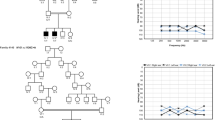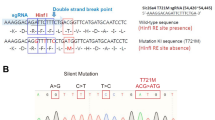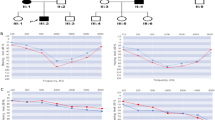Abstract
Many proteins necessary for sound transduction have been identified through positional cloning of genes that cause deafness1,2,3. We report here that mutations of LRTOMT are associated with profound nonsyndromic hearing loss at the DFNB63 locus on human chromosome 11q13.3–q13.4. LRTOMT has two alternative reading frames and encodes two different proteins, LRTOMT1 and LRTOMT2, detected by protein blot analyses. LRTOMT2 is a putative methyltransferase. During evolution, new transcripts can arise through partial or complete coalescence of genes4. We provide evidence that in the primate lineage LRTOMT evolved from the fusion of two neighboring ancestral genes, which exist as separate genes (Lrrc51 and Tomt) in rodents.
This is a preview of subscription content, access via your institution
Access options
Subscribe to this journal
Receive 12 print issues and online access
$209.00 per year
only $17.42 per issue
Buy this article
- Purchase on Springer Link
- Instant access to full article PDF
Prices may be subject to local taxes which are calculated during checkout





Similar content being viewed by others
Accession codes
Accessions
NCBI Reference Sequence
Protein Data Bank
References
Friedman, T.B. & Griffith, A.J. Human nonsyndromic sensorineural deafness. Annu. Rev. Genomics Hum. Genet. 4, 341–402 (2003).
Grant, L. & Fuchs, P.A. Auditory transduction in the mouse. Pflugers Arch. 454, 793–804 (2007).
Morton, C.C. & Nance, W.E. Newborn hearing screening–a silent revolution. N. Engl. J. Med. 354, 2151–2164 (2006).
Pasek, S., Risler, J.L. & Brezellec, P. Gene fusion/fission is a major contributor to evolution of multi-domain bacterial proteins. Bioinformatics 22, 1418–1423 (2006).
Kalay, E. et al. A novel locus for autosomal recessive nonsyndromic hearing impairment, DFNB63, maps to chromosome 11q13.2-q13.4. J. Mol. Med. 85, 397–404 (2007).
Khan, S.Y. et al. Autosomal recessive nonsyndromic deafness locus DFNB63 at chromosome 11q13.2-q13.3. Hum. Genet. 120, 789–793 (2007).
Tlili, A. et al. Localization of a novel autosomal recessive non-syndromic hearing impairment locus DFNB63 to chromosome 11q13.3-q13.4. Ann. Hum. Genet. 71, 271–275 (2007).
Gregory-Evans, C.Y. et al. SNP genome scanning localizes oto-dental syndrome to chromosome 11q13 and microdeletions at this locus implicate FGF3 in dental and inner-ear disease and FADD in ocular coloboma. Hum. Mol. Genet. 16, 2482–2493 (2007).
Tekin, M. et al. Homozygous mutations in fibroblast growth factor 3 are associated with a new form of syndromic deafness characterized by inner ear agenesis, microtia, and microdontia. Am. J. Hum. Genet. 80, 338–344 (2007).
Akiva, P. et al. Transcription-mediated gene fusion in the human genome. Genome Res. 16, 30–36 (2006).
Chung, W.Y., Wadhawan, S., Szklarczyk, R., Pond, S.K. & Nekrutenko, A. A first look at ARFome: dual-coding genes in mammalian genomes. PLoS Comput. Biol. 3, e91 (2007).
Kapranov, P., Willingham, A.T. & Gingeras, T.R. Genome-wide transcription and the implications for genomic organization. Nat. Rev. Genet. 8, 413–423 (2007).
Liang, H. & Landweber, L.F. A genome-wide study of dual coding regions in human alternatively spliced genes. Genome Res. 16, 190–196 (2006).
Parra, M.K., Tan, J.S., Mohandas, N. & Conboy, J.G. Intrasplicing coordinates alternative first exons with alternative splicing in the protein 4.1R gene. EMBO J. 27, 122–131 (2008).
Quelle, D.E., Zindy, F., Ashmun, R.A. & Sherr, C.J. Alternative reading frames of the INK4a tumor suppressor gene encode two unrelated proteins capable of inducing cell cycle arrest. Cell 83, 993–1000 (1995).
Bordo, D. & Argos, P. Suggestions for “safe” residue substitutions in site-directed mutagenesis. J. Mol. Biol. 217, 721–729 (1991).
Bonifacio, M.J. et al. Kinetics and crystal structure of catechol-o-methyltransferase complex with co-substrate and a novel inhibitor with potential therapeutic application. Mol. Pharmacol. 62, 795–805 (2002).
Dallos, P. & Fakler, B. Prestin, a new type of motor protein. Nat. Rev. Mol. Cell Biol. 3, 104–111 (2002).
Liberman, M.C. et al. Prestin is required for electromotility of the outer hair cell and for the cochlear amplifier. Nature 419, 300–304 (2002).
Frolenkov, G.I., Atzori, M., Kalinec, F., Mammano, F. & Kachar, B. The membrane-based mechanism of cell motility in cochlear outer hair cells. Mol. Biol. Cell 9, 1961–1968 (1998).
Holley, M.C. & Ashmore, J.F. Spectrin, actin and the structure of the cortical lattice in mammalian cochlear outer hair cells. J. Cell Sci. 96, 283–291 (1990).
Holley, M.C., Kalinec, F. & Kachar, B. Structure of the cortical cytoskeleton in mammalian outer hair cells. J. Cell Sci. 102, 569–580 (1992).
Nishida, Y., Fujimoto, T., Takagi, A., Honjo, I. & Ogawa, K. Fodrin is a constituent of the cortical lattice in outer hair cells of the guinea pig cochlea: immunocytochemical evidence. Hear. Res. 65, 274–280 (1993).
Lautala, P., Ulmanen, I. & Taskinen, J. Molecular mechanisms controlling the rate and specificity of catechol O-methylation by human soluble catechol O-methyltransferase. Mol. Pharmacol. 59, 393–402 (2001).
Zhu, B.T. Catechol-O-Methyltransferase (COMT)-mediated methylation metabolism of endogenous bioactive catechols and modulation by endobiotics and xenobiotics: importance in pathophysiology and pathogenesis. Curr. Drug Metab. 3, 321–349 (2002).
Gogos, J.A. et al. Catechol-O-methyltransferase-deficient mice exhibit sexually dimorphic changes in catecholamine levels and behavior. Proc. Natl. Acad. Sci. USA 95, 9991–9996 (1998).
Ahmed, Z.M. et al. Mutations of the protocadherin gene PCDH15 cause Usher syndrome type 1F. Am. J. Hum. Genet. 69, 25–34 (2001).
Collin, R.W. et al. Mutations of ESRRB encoding estrogen-related receptor beta cause autosomal-recessive nonsyndromic hearing impairment DFNB35. Am. J. Hum. Genet. 82, 125–138 (2008).
Belyantseva, I.A. et al. Myosin-XVa is required for tip localization of whirlin and differential elongation of hair-cell stereocilia. Nat. Cell Biol. 7, 148–156 (2005).
Ahmed, Z.M. et al. PCDH15 is expressed in the neurosensory epithelium of the eye and ear and mutant alleles are responsible for both USH1F and DFNB23. Hum. Mol. Genet. 12, 3215–3223 (2003).
Acknowledgements
We thank the families for their participation in this study, which was supported by NIDCD/NIH (intramural research fund ZO1DC00035-06 and ZO1DC00035-06 to T.B.F., ZO1DC000060 and ZO1DC000064 to A.J.G.), funds from the European Commission FP6 Integrated Project EUROHEAR (contract number LSHG-CT-20054-512063:2), the Heinsius Houbolt Foundation and the Karadeniz Technical University Research Fund (contract numbers 2002.114.001.3 and 2006.114.001.1). In Tunisia work was also funded by Le Ministère de l'Enseignement Supérieur, de la Recherche Scientifique et de la Technologie, Tunisia. In Pakistan the Higher Education Commission and the Ministry of Science and Technology in Islamabad, Pakistan supported this project. We thank B. Ploplis, M. Ansari, A. Lagziel, E. Boger, S. Kitajiri, E. van Wijk, T. Peters and H. Spierenburg for their technical help and G. Vriend, F. Cremers, H. Brunner and C. Cremers for discussion. We also thank J. Bird, D. Drayna, M. Meisler and S. Sullivan for advice and comments in preparing the manuscript. We thank the Southwest National Primate Research Center, San Antonio, Texas for providing brain tissue samples from chimpanzee and baboon, and the Duke Lemur Center, Durham, North Carolina for brain tissue samples from a lemur.
Author information
Authors and Affiliations
Contributions
Z.M.A., T.B.F., S.M., E.K. and H.K. conceived and directed the project; Z.M.A. performed linkage, RT-PCR, western and mutational analyses, cloned isoforms, provided bioinformatic evaluations, prepared figures and co-wrote the manuscript; S.M. enrolled Tunisian families, performed linkage analyses, mutational screening, molecular modeling and helped write the manuscript; E.K. enrolled family TR57 and Turkish controls, performed linkage analysis in family TR57, screened for mutations and did expression profile analysis in human fetal tissues; I.A.B. conducted immunocytochemistry, interpreted results and helped write the manuscript; M.A.M. enrolled Tunisian families and performed genetic linkage and mutational screening; R.W.J.C. performed in situ hybridizations and mutation analysis of candidate genes in the Turkish family; Saima Riazuddin ascertained Pakistani families, helped with RT-PCR analyses and editing the manuscript; M.H.-A. enrolled Tunisian families and performed genetic linkage analyses; H.V. conducted the molecular modeling and helped with the writing; M.N.K. performed mutational analyses; A.T. enrolled Tunisian families and performed genetic linkage analyses; B.v.d.Z. prepared the cRNA in situ hybridization probes and performed hybridizations; S.Y.K. mapped DFNB63 and ascertained Pakistani families; L.A. performed molecular modeling; S.A.R. obtained clinical data for FGF3 and DFNB63 families; R.J.M. evaluated experimental designs and data, and helped write the manuscript; A.J.G. planned clinical evaluation and evaluated the data, and edited the manuscript; I.C. enrolled and examined Tunisian families; R.Ç. performed audiological testing of family TR57; J.O. helped with mutational analyses of TR57; A.K. supervised the work at the Karadeniz Technical University in Trabzon; A.G. directed clinical evaluations in Tunisia; Sheikh Riazuddin directed all work in Pakistan; T.B.F. directed work at the NIDCD, helped with data interpretation and co-wrote the manuscript; H.A. directed work in Tunisia; H.K. directed work at Radboud University Nijmegen, helped with data interpretation and co-wrote the manuscript.
Corresponding authors
Supplementary information
Supplementary Text and Figures
Supplementary Figures 1–8, Supplementary Tables 1 and 2 (PDF 2618 kb)
Rights and permissions
About this article
Cite this article
Ahmed, Z., Masmoudi, S., Kalay, E. et al. Mutations of LRTOMT, a fusion gene with alternative reading frames, cause nonsyndromic deafness in humans. Nat Genet 40, 1335–1340 (2008). https://doi.org/10.1038/ng.245
Received:
Accepted:
Published:
Issue Date:
DOI: https://doi.org/10.1038/ng.245
This article is cited by
-
Identification a novel pathogenic LRTOMT mutation in Mauritanian families with nonsyndromic deafness
European Archives of Oto-Rhino-Laryngology (2023)
-
Molecular aetiology of ski-slope hearing loss and audiological course of cochlear implantees
European Archives of Oto-Rhino-Laryngology (2022)
-
Genetics and meta-analysis of recessive non-syndromic hearing impairment and Usher syndrome in Maghreb population: lessons from the past, contemporary actualities and future challenges
Human Genetics (2022)
-
ARNSHL gene identification: past, present and future
Molecular Genetics and Genomics (2022)
-
Mechanisms in cochlear hair cell mechano-electrical transduction for acquisition of sound frequency and intensity
Cellular and Molecular Life Sciences (2021)



